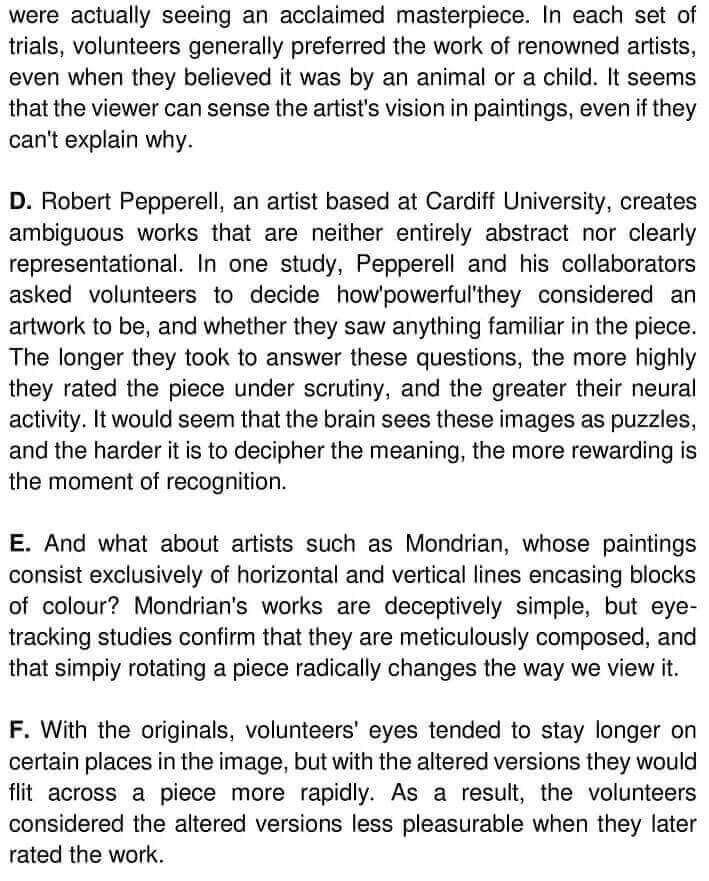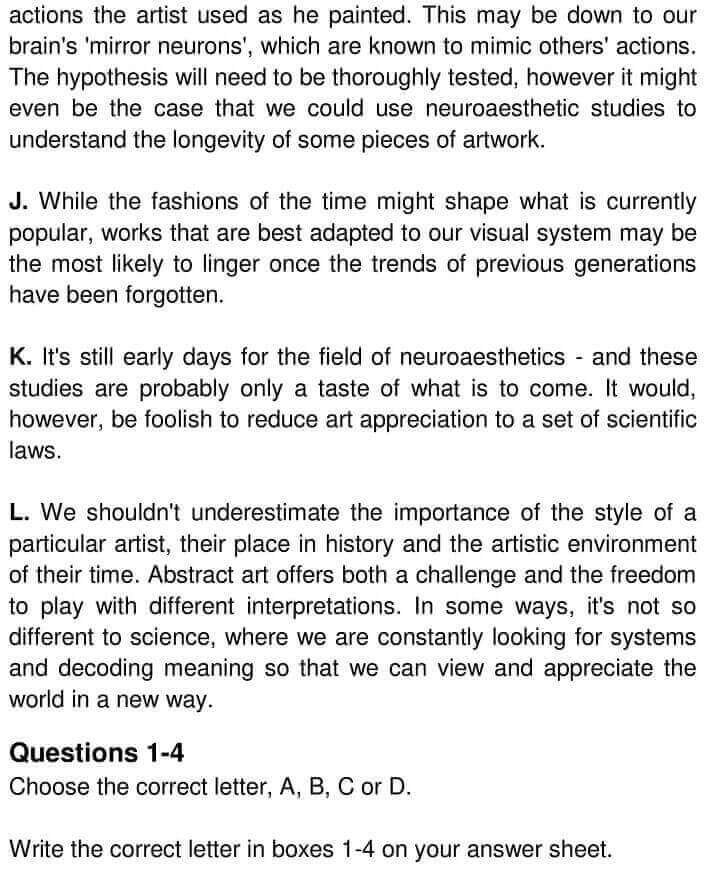Neuroaesthetics – IELTS Reading Answers
7 min read
Updated On
-
Copy link
Table of Contents

Limited-Time Offer : Access a FREE 10-Day IELTS Study Plan!
The Academic passage ‘Neuroaesthetics’ is a reading passage that appeared in an IELTS Test.
It contains some of the IELTS reading question types. If you are interested in familiarising yourself with all the question types, don’t hesitate to take an IELTS reading practice test.
Neuroaesthetics








Answers
Unlock Answers
| Question number | Answer | Explanation |
|---|---|---|
| 1 | C | Paragraph B informs us that we certainly do have an inclination to follow the crowd. For example, when people are asked to make simple perceptual decisions such as matching a shape to its rotated image (shape-matching test), people often choose a definitively wrong answer if they see others doing the same. This means that they (or all of us) are easily influenced by others’ opinions even if they are wrong. Hence, the answer is C (our tendency to be influenced by the opinions of others). |
| 2 | D | Paragraph C refers to Angelina Hawley-Dolan’s study where she asked volunteers to view pairs of paintings – either the creations of famous abstract artists or the doodles of infants, chimps and elephants. Then they had to judge which they preferred. A third of the paintings were given no captions, while many were labelled incorrectly to confuse the volunteers. In each set of trials, volunteers generally preferred the work of renowned artists, even when they believed it was by an animal or a child. It seems that the viewer can sense the artist’s vision in paintings (people have the ability to perceive the intention behind works of art), even if they can’t explain why. Hence, the answer is D (have the ability to perceive the intention behind works of art). |
| 3 | B | Paragraph D mentions that Robert Pepperell, an artist based at Cardiff University, creates ambiguous works that are neither entirely abstract nor clearly representational. In one study, Pepperell and his collaborators asked volunteers to decide how ‘powerful’ they considered an artwork to be, and whether they saw anything familiar in the piece. It seemed from the study that the brain sees these images as puzzles, and the harder it is to decipher the meaning, the more rewarding is the moment of recognition, that is, when a person understands the work of art, he/she feels satisfied. Hence, the answer is B (find it satisfying to work out what a painting represents). |
| 4 | A | Paragraph E lets us know that Mondrian’s works are deceptively simple, but eye-tracking studies confirm that they are meticulously composed, and that simply rotating a piece radically changes the way we view it. It means that Mondrain’s works may seem to be simple but they are arranged carefully in such a way that changing the position will change its outlook. Hence, the answer is A (They are more carefully put together than they appear). |
| 5 | C | Paragraph A explains that the blurred imagery of Impressionist paintings seems to stimulate the brain’s amygdala. Since the amygdala plays a crucial role in our feelings (emotions), that finding might explain why many people find these pieces so moving. So, we can conclude that the Impressionist paintings affect the amygdala in our brains which, in turn, demonstrate the impact on our emotions. Hence, the answer is C (emotions). |
| 6 | B | Paragraph G indicates that Alex Forsythe of the University of Liverpool analysed the visual intricacy of different pieces of art, and her results suggest that many artists use (many artists give) a key level of detail (degree of complexity) to please the brain (appeals to the viewer’s brain). Hence, the answer is B (complexity). |
| 7 | H | Paragraph H brings forward the fact that Alex Forsythe of the University of Liverpool analysed the visual intricacy of different pieces of art. She found that appealing pieces (pleasing works of art) both abstract and representational, show signs of ‘fractals’ – repeated motifs (repeated images) recurring (occur frequently) in different scales, fractals are common throughout nature (occur frequently in the natural world), for example in the shapes of mountain peaks or the branches of trees.
Hence, the answer is H (images). |
| 8 | NOT GIVEN | In paragraph H, it is given that Alex Forsythe analysed the visual intricacy of different pieces of art. According to her, appealing pieces show signs of ‘fractals’. It is possible that our visual system, which evolved in the great outdoors, finds it easier to process such patterns. This is the only reference of Forsythe and her works and there is no information if her findings contradicted previous beliefs on the function of ‘fractals’ in art. Hence, the answer is NOT GIVEN. |
| 9 | YES | Paragraph I states that Pollock’s works (certain ideas) feel so dynamic because the brain (brain’s ‘mirror neurons’, which are known to mimic others’ actions) reconstructs the energetic actions the artist used as he painted (link between ‘mirror neurons’ and art appreciation). But the hypothesis will need to be thoroughly tested (require further verification). As the statement agrees with the views of the author, the answer is YES. |
| 10 | NO | Paragraph J tells us that while the fashions of the time might shape what is currently popular, works that are best adapted to our visual system (people’s taste in paintings) may be the most likely to linger once the trends of previous generations have been forgotten. So, the taste in art may not change with the current artistic trends of the period. As the statement contradicts the views of the author, the answer is NO. |
| 11 | NO | Paragraph K specifies that it’s still early days for the field of neuroaesthetics and these studies are probably only a taste of what is to come. But it would be foolish to reduce art appreciation to a set of scientific laws. So, the author means that even though the field of neuroaesthetics might develop, yet scientists would not be able to define the precise rules which govern people’s reactions to works of art.
As the statement contradicts the views of the author, the answer is NO. |
| 12 | YES | Paragraph L declares that while appreciating art, we should not underestimate the importance of the style of a particular artist, their place in history and the artistic environment of their time (the cultural context in which an artist worked), rather, we should take them into consideration. As the statement agrees with the views of the author, the answer is YES. |
| 13 | NOT GIVEN | In the last part of paragraph L it is noted that abstract art offers both a challenge and the freedom to play with different interpretations. In some ways, it’s not so different to science, where we are constantly looking for systems and decoding meaning so that we can view and appreciate the world in a new way. As there is no reference if it is easier to find meaning in the field of science than in that of art, the answer is NOT GIVEN. |
| 14 | A | In paragraph A, the author introduces the topic and says that an emerging discipline called neuroaesthetics is seeking to bring scientific objectivity to the study of art, and has already given us a better understanding of many masterpieces. The blurred imagery of Impressionist paintings seems to stimulate the brain’s amygdala. Further, in paragraph D, it is written that in one study, Pepperell and his collaborators found out that the brain sees images as puzzles, and the harder it is to decipher the meaning, the more rewarding is the moment of recognition. Paragraph F adds that in a study, Oshin Vartanian of Toronto University Miro found that changing the composition of the paintings reduced activation in those brain areas linked with meaning and interpretation. The next paragraph, G, describes Alex Forsythe’s work that analysed the visual intricacy of different pieces of art, and her results suggest that many artists use a key level of detail to please the brain. From these references from the passage we can find out that the passage is discussing how different studies have provided us insights into how the brain responds to abstract art. On the other hand, it does not deal with neural activity of abstract artists, comparison of the neurological bases of abstract and representational art or shows us how brain research has altered public opinion about abstract art. Hence, the answer is A (Some scientific insights into how the brain responds to abstract art). |
Check More IELTS Reading Answers
Also check :
Practice IELTS Reading based on question types

Start Preparing for IELTS: Get Your 10-Day Study Plan Today!
Recent Articles

Nehasri Ravishenbagam

Haniya Yashfeen

Haniya Yashfeen

Haniya Yashfeen




Post your Comments